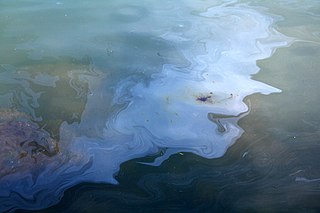In biology, syntrophy, synthrophy, or cross-feeding is the phenomenon of one species living off of the metabolic products of another species. In this type of biological interaction, the growth of one partner depends on the nutrients, growth factors, or substrates provided by the other partner. Jan Dolfing describes syntrophy as "the critical interdependency between producer and consumer". This term for nutritional interdependence is often used in microbiology to describe this symbiotic relationship between bacterial species. Morris et al. have described the process as "obligately mutualistic metabolism".
Acinetobacter calcoaceticus is a bacterial species of the genus Acinetobacter. It is a nonmotile, gram negative coccobacillus. It grows under aerobic conditions, is catalase positive and oxidase negative. A. calcoaceticus is a part of the A. calcoaceticus-A. baumannii complex together with Acinetobacter baumannii, Acinetobacter nosocomialis, Acinetobacter pitti and Acinetobacter seifertii.
Desulfatibacillum alkenivorans AK-01 is a specific strain of Desulfatibacillum alkenivorans.

Alcanivorax borkumensis is an alkane-degrading marine bacterium which naturally propagates and becomes predominant in crude-oil-containing seawater when nitrogen and phosphorus nutrients are supplemented.
Acinetobacter junii is a species of bacteria. Its type strain is ATCC 17908. It can be pathogenic. This bacterium has been linked to nosocomial infections including catheter-related blood stream infections and cellulitis.
Pelobacter venetianus is a species of bacteria that degrades polyethylene glycol. It is strictly anaerobic, gram-negative and non-spore-forming.
Acinetobacter ursingii is a species of potentially pathogenic bacteria. Its type strain is LUH 3792T.
Acinetobacter schindleri is a species of bacteria. It is potentially pathogenic. Its type strain is LUH 5832T.
Alcanivorax dieselolei is a species of alkane-degrading bacteria. Its genome has been sequenced. It is halophilic, aerobic, Gram-negative, non-spore-forming, catalase- and oxidase-positive, motile and rod-shaped. Its type strain is B-5T.
Alcanivorax pacificus is a pyrene-degrading marine gammaprotobacterium. It is of the genus Alcanivorax, a group of marine bacteria known for degrading hydrocarbons. When originally proposed, the genus Alcanivorax comprised six distinguishable species. However, A. pacificus, a seventh strain, was isolated from deep sea sediments in the West Pacific Ocean by Shanghai Majorbio Bio-pharm Technology Co., Ltd. in 2011. A. pacificus’s ability to degrade hydrocarbons can be employed for cleaning up oil-contaminated oceans through bioremediation. The genomic differences present in this strain of Alcanivorax that distinguish it from the original consortium are important to understand to better utilize this bacteria for bioremediation.
Novosphingobium pentaromativorans is a species of high-molecular-mass polycyclic aromatic hydrocarbon-degrading bacterium. It is Gram-negative, yellow-pigmented and halophilic. With type strain US6-1T. Its genome has been sequenced.
Acinetobacter beijerinckii is a gram-negative, strictly aerobic bacterium from the genus of Acinetobacter which was isolated from human and animal specimens and from different environmental sources.
Acinetobacter bereziniae is a gram-negative, strictly aerobic bacterium from the genus Acinetobacter.
Acinetobacter guillouiae is a gram-negative, strictly aerobic bacterium from the genus Acinetobacter isolated from gasworks effluent.
Acinetobacter gyllenbergii is a gram-negative, oxidase-negative, catalase-positive, strictly aerobic nonmotile bacterium from the genus Acinetobacter isolated from human clinical specimens. It is named in honour of Finnish bacteriologist and taxonomist Helge G. Gyllenberg.
Acinetobacter nosocomialis is a gram-negative, strictly aerobic bacterium from the genus Acinetobacter isolated from a patient at MetroHealth in Cleveland, Ohio. Acinetobacter nosocomialis belongs to the Acinetobacter calcoaceticus-baumannii complex.
Acinetobacter pittii is a Gram-negative, oxidase-negative, catalase-positive, strictly aerobic, nonmotile bacterium from the genus Acinetobacter. A. pittii belongs to the Acinetobacter calcoaceticus-baumannii complex and is named after the British microbiologist Tyrone Pitt. Bacteria of the genus Acinetobacter are ubiquitously distributed in nature. They are Gram-negative, strictly aerobic, nonmotile, diplococcoid rods that are oxidase negative and catalase positive. They are found in various types of soils and waters and are occasionally found in foodstocks. They are normal inhabitants of human skin and are capable of transitory colonization of the upper respiratory tract. They can cause infection in debilitated patients. DNA-DNA hybridization studies have been used to identify DNA groups within the genus Acinetobacter.
Ochrobactrum tritici is a species of bacteria first isolated from wheat rhizoplane. Its type strain is SCII24T.
Micromonospora citrea is an endophytic actinomycete, with type strain DSM 43903T. It produces citreamicins, several types of antibacterial antibiotics.
The PTS Galactitol (Gat) Family is part of the PTS-AG superfamily. The biochemistry of this family is poorly defined. The only well-characterized member of this family is the galactitol permease of Escherichia coli. However, a homologous IIC protein from Listeria monocytogenes has been shown to be required for D-arabitol fermentation. It presumably functions together with IIAGat and IIBGat homologues. IICGat is distantly related to IICSgc of E. coli; IIAGat is distantly related to IIASga and IIASgcof E. coli as well as IIAMtl and IIAFru. IIBGat is distantly related to IIBSga and IIBSgc of E. coli. Domains in the LicR/CelR family of transcriptional activators show C-terminal domains exhibiting weak sequence similarity to IIBGat and IIAGat.
